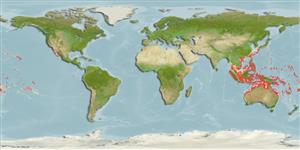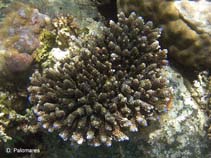Acropora hyacinthus (Dana, 1846)
Brush coral| Native range | All suitable habitat | Point map | Year 2050 |

|
| This map was computer-generated and has not yet been reviewed. |
| Acropora hyacinthus AquaMaps Data sources: GBIF OBIS |
Classification / Names Common names | Synonyms | CoL | ITIS | WoRMS
Anthozoa | Scleractinia | Acroporidae
Environment: milieu / climate zone / depth range / distribution range Ecology
Reef-associated; depth range 0 - 52 m (Ref. 100896). Tropical; 35°N - 34°S, 95°E - 108°W (Ref. 846)
Distribution Countries | FAO areas | Ecosystems | Occurrences | Introductions
Indo-Pacific. Tropical to subtropical.
Length at first maturity / Size / Weight / Age
Maturity: Lm ? range ? - ? cm
Short description Morphology
This is the classic "table" coral, with long-lived colonies forming tables several metres in diameter. The coral is supported by a central stalk; the main braches anastomose in the horizontal plane, while secondary branchlets all grow vertically to the same height, forming a flat surface (Ref. 269).
Common at shallow to intermediate depths throughout its range (Ref. 269). Upper reef slopes; outer reef flats (Ref. 846). Has very high bleaching level and estimated mortality nearing 100% in Palau (Ref. 66144).
Life cycle and mating behavior Maturity | Reproduction | Spawning | Eggs | Fecundity | Larvae
Hermaphroditic (Refs. 97272, 113708, 113712).
Main reference
References | Coordinator | Collaborators
Hodgson, G. 1998. (Ref. 269)
IUCN Red List Status (Ref. 130435)
Near Threatened (NT) ; Date assessed: 01 January 2008
CITES status (Ref. 108899)
Appendix II: International trade monitored
CMS (Ref. 116361)
Not Evaluated
Threat to humans
Human uses
| FishSource |
Tools
More information
Internet sources
BHL | BOLD Systems | CISTI | DiscoverLife | FAO(Publication : search) | Fishipedia | GenBank (genome, nucleotide) | GloBI | Gomexsi | Google Books | Google Scholar | Google | PubMed | Hexacorallians of the World | Tree of Life | Wikipedia (Go, Search) | Zoological Record
Estimates based on models
Preferred temperature
(Ref. 115969): 24.3 - 29, mean 27.9 (based on 844 cells).
Price category
(Ref. 80766):
Unknown.



